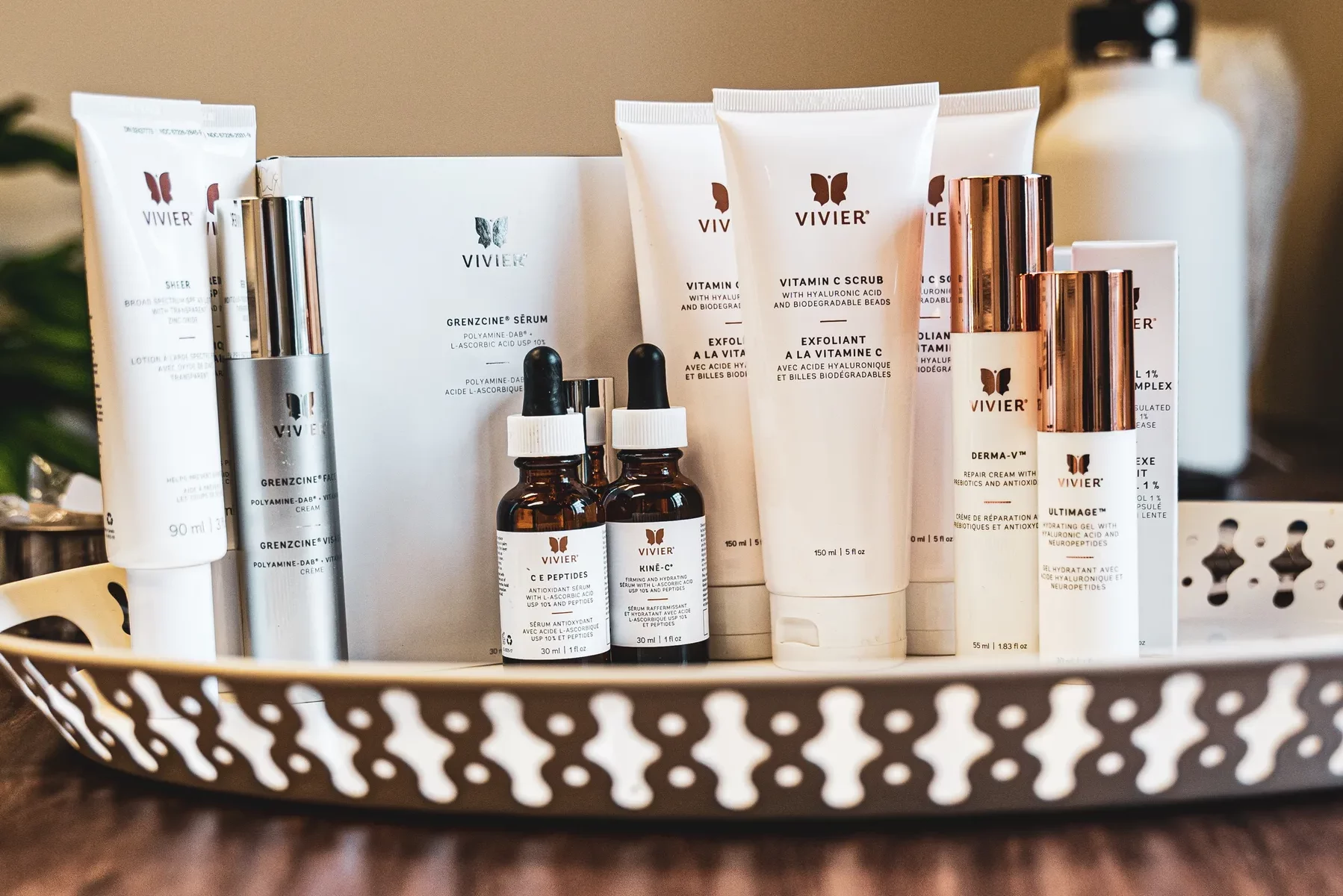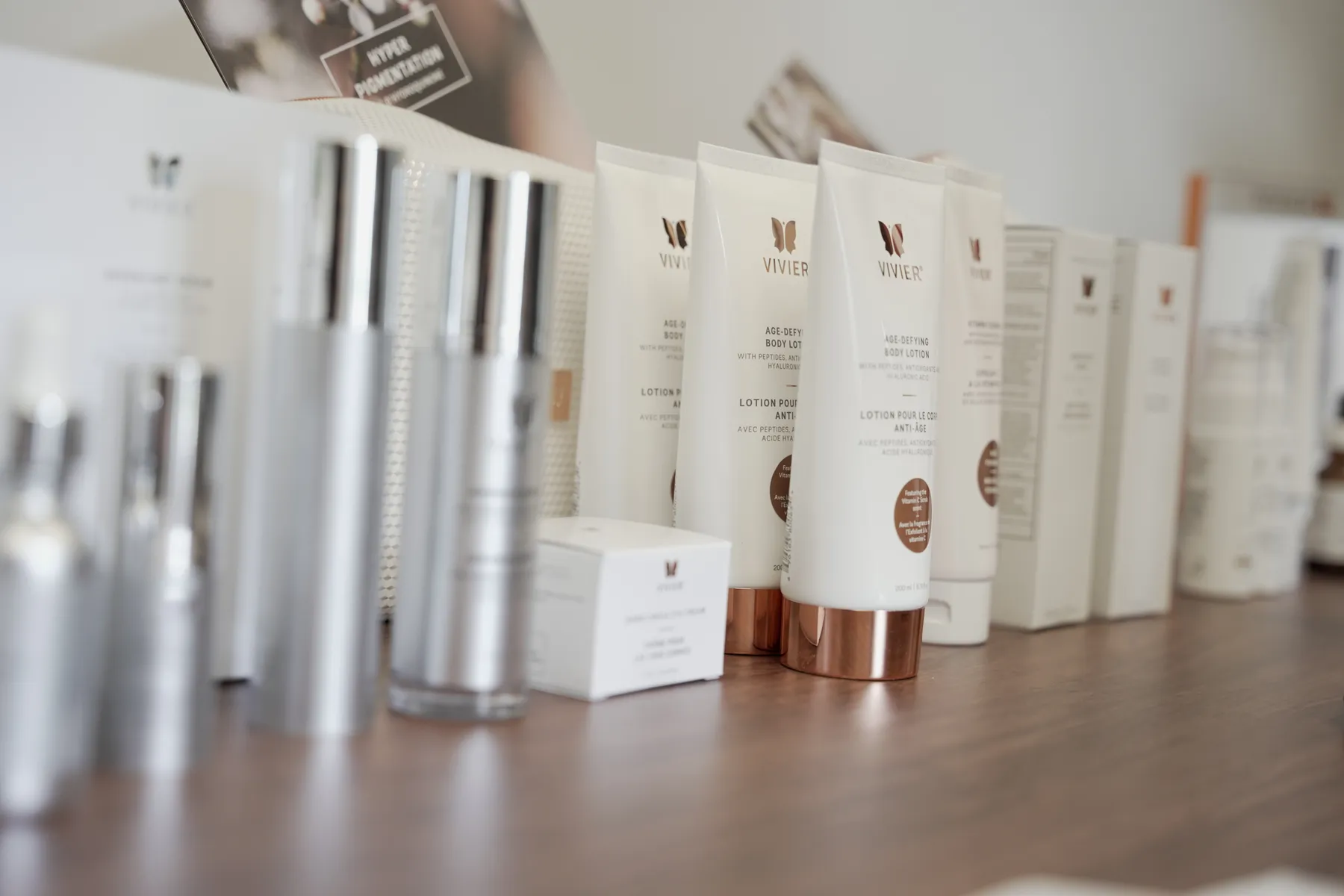
Ottawa Medical Grade Skin Care
Elevate your skincare routine with the finest selection of medical-grade skincare products. Our expertly curated range is designed to address your unique skin concerns, ensuring healthier, more radiant skin.
View Our Skin Care Products


All of our formulations contain GliSODin®: the only bioavailable source of superoxide dismutase (SOD). Also known as the ‘enzyme of life’, SOD affords unparalleled protection against free-radical damage at the cellular level. A truly complete and effective skincare routine should include a nutricosmetic supplement in order to address internal oxidative stress.
Growth Of Eyelash
How To Approach Skin Care
At the heart of skin care is sun protection. Do you use SPF? Not only does it maintain healthy skin, but it also protects your skin cells without preventing a tan.
Next, evaluate your skincare routine. Are you incorporating active ingredients like Retinol, Vitamin C, or hydroquinone to manage Melasma? How often do you exfoliate? Is washing your face twice daily a habit?
Promoting skin cell turnover is vital for a radiant complexion. Over time, as the skin loses its natural ability to shed dead cells, it can appear dull and feel rough. Retinol can help accelerate this turnover, revealing fresher and healthier-looking skin. Though the transition may be challenging, the glowing results, tighter skin, and minimized pores are truly worth it.
While treatments like Botox and fillers have their place, the foundation of beauty is healthy skin. At JG Medical Cosmetology, we believe in a holistic approach to beauty, with skin health at its core.
The Path To Radiant Skin
Proven Efficacy
Medical-grade skincare products are rigorously tested and formulated with high-quality ingredients to deliver visible results. They have a track record of effectively addressing various skin concerns.
Professional Guidance
When you choose medical-grade skincare, you often receive guidance from or skincare experts who can recommend products tailored to your specific needs, ensuring a personalized and effective skincare routine.
Skin Care Excellence
Investing in medical-grade skincare products is a smart choice for those seeking superior results in their skincare regimen. These products are meticulously crafted with potent ingredients, backed by scientific research, and designed to address a wide range of skin concerns.
Whether you’re targeting signs of aging, acne, pigmentation, or simply want to maintain healthy skin, medical-grade skincare offers advanced formulations and professional guidance to help you achieve your skincare goals effectively.
Elevate your skincare routine with products that have been proven to deliver visible and lasting improvements in skin texture and appearance.
Medical Grade Skin Care Frequently Asked Questions
What causes acne?
Acne can be caused by excess sebum oil and clogged pores. Doctors aren’t sure why some people get acne and others do not, but some research suggests that hormone levels may play a role.
Acne is most common in young adults with increasing hormone levels, and about 80 percent of people will have at least one [acne] outbreak before age 30. It is less common in older adults, who tend to have steadier hormone levels. Since stress can affect hormones, it may also play a role in the development of acne, but so far, there is no definitive evidence that factors such as stress, diet, or light makeup have any links with acne. If you have acne, wash gently with a mild cleanser no more than twice a day; and avoid hard scrubbing, exfoliating, and touching the affected areas.
What are the most important parts of a skincare routine?
Since sun damage increases the risk of skin cancer, as well as skin problems ranging from wrinkles to dark spots, wearing sunscreen on a daily basis is essential. Choose a broad-spectrum sunscreen with a minimum sun protection factor (SPF) of 30. Beyond that, it takes just a few minutes each morning and each evening to do the basics: washing with a gentle cleanser and applying a moisturizer to your face and neck.
How can I avoid wrinkles?
Wrinkles are a natural result of aging, but you can delay their onset or minimize their appearance. To do so, limit sun exposure, wear sunscreen every day, and use skin products that contain antioxidants and retinoids, which can reduce fine lines and wrinkles.
What should I do about dark spots?
UV exposure and hormonal changes are two causes of dark spots. Avoiding the sun and wearing sunscreen can prevent new dark spots from forming, while exfoliating regularly or using prescription medications may help treat the existing spots you already have. Certain dark spot correctors or moisturizers may also make a difference over time. Remember to choose the products that are formulated for your skin type.
How can I prevent aging skin?
As your skin loses elasticity and collagen, it naturally begins to appear wrinkled and saggy. By caring for it and focusing on prevention, you can minimize these issues. Apply a broad-spectrum sunscreen every day, and consider using eye creams and other topical products that contain retinoids and antioxidants, which can help improve the appearance of wrinkles and sagging skin.
What’s the best way to handle sensitive skin?
Be gentle with it! Always wash sensitive skin gently, and never use harsh cleansers. Avoid products that contain irritating substances. Instead, seek out those that are specifically labeled for sensitive skin.
How do I know if a product is right for me
Sometimes, there is no way to tell for sure unless you try it. Usually, however, you can make an educated guess by examining the product’s label and ingredient list. To increase the chance that products won’t irritate your skin, seek out those that are fragrance-free, contain little or no alcohol, and are labeled “suitable for sensitive skin”.
Do I really need to wear sunscreen every day?
In short, yes! If you care about your skin, wearing a broad-spectrum sunscreen with a minimum SPF of 30 is the one thing you can do to protect it most. Sunscreen helps decrease the risk of skin cancer and other negative effects including wrinkles, fine lines, freckles, and hallowness.
How can I fix an uneven skin tone?
An uneven skin tone is caused by an uneven distribution of pigment. Sun exposure and hormonal changes can also contribute to this issue. Certain serums, creams or moisturizers, especially those that contain vitamin C, can all help to even out your skin tone. It is also possible that your skin can develop an uneven tone due to a buildup of dead skin cells. If that is the issue, a simple way to even out your skin tone is to exfoliate once a day or every couple of days.
How do I find out my skin type?
Typically, skin is classified in just a few categories, including normal, oily, dry, and sensitive. If you have combination skin, it means your skin is one type in one area and another type in another area (oily around your T-zone but normal everywhere else, for instance). Your skin type can change over time and can also be affected by factors such as hormones, medications, and diet. To get a good idea of what your skin type might be, wash it gently and leave it product-free for several hours before examining it closely to observe different areas.
You know your skin best. Paying attention to how it looks, feels and acts on a day-to-day basis, as well as how it reacts to different skin care products, is the best starting point to finding a routine that will leave you feeling healthy, rejuvenated and vibrant for many years to come.
Latisse Frequently Asked Questions
What is Latisse?
Latisse is a liquid solution that you apply to the base of your upper eyelids. Used daily, it can increase the length of your eyelashes. Latisse can also make your eyelashes thicker, giving them greater prominence, as well as causing them to take on a darker color.
The Latisse liquid solution contains an active ingredient called bimatoprost. Bimatoprost was approved by the FDA for a different purpose in 2001, then approved specifically for use as an eyelash growth medication in 2008.
How Does Latisse Work?
Right now,experts aren’t completely sure how Latisse works to improve the length, thickness and color of your eyelashes. Currently, the scientific data suggests that Latisse increases the amount of time your eyelashes spend in the growth phase of the hair cycle.
Does Latisse Actually Work?
Yes. According to data from the FDA, 79 percent of people who use Latisse experience at least one grade increase in Global Eyelash Assessment (GEA) score after using the medication for 20 weeks or longer.
Can Latisse Treat Eyelashes Hypotrichosis?
Yes. Used daily at a normal dose, Latisse is an effective treatment for eyelashes hypotrichosis, a condition that causes inadequate growth of the eyelashes. In fact, Latisse is often prescribed specifically to treat this condition.
Latisse is also prescribed to treat certain forms of eyelash hair loss caused by medications, as well as for cosmetic purposes. If you have a condition that affects the length and thickness of your eyelashes, Latisse may be an effective treatment option.
How Long Does Latisse Take to Work?
Like many other medications, the results of Latisse aren’t instant. Normally, you’ll start to notice some improvements in the length, thickness and darkness of your eyelashes after using Latisse daily for two months.
If you use Latisse every other day, or occasionally forget to use it, it may take slightly longer for the medication to start working. It typically takes three to four months before you’ll see the final results of Latisse.
How Long Does Latisse Last?
Latisse works as long as you continue using it, meaning you can keep applying it daily after four to five months have passed in order to maintain your results. Your eyelashes will still go through their normal growth cycle, but they’ll maintain any extra length, thickness and color.
Many people who use Latisse switch to using it every other day after reaching their desired lash length and thickness.
If you stop using Latisse, your eyelashes will gradually lose the extra thickness, length and color provided by the medication until they reach their previous appearance. This can take anywhere from a few weeks to several months or more.
Is Latisse Easy to Use?
Latisse is a very easy medication to use. Applying Latisse to your eyelids is a simple process that you can complete using the sterile applicators included with the medication. In all, it only takes a few minutes every day to apply Latisse properly.
It’s important to apply Latisse according to the instructions provided with the mediation. Like other eye medications, Latisse can cause irritation if you apply it using unclean equipment or without first washing your face and hands.
Our guide to Latisse also includes a step-by-step guide to applying Latisse that covers everything from pre-application clean-up to the best times of day to use Latisse.
When is the Best Time to Apply Latisse?
Allergan, the manufacturer of Latisse, recommends applying the medication at night, shortly before bed. If you apply Latisse one hour before you plan to go to sleep, the liquid solution will have more than enough time to dry and soak into your skin.
Although Latisse is designed for use at night, it’s okay to use it in the morning to a clean, makeup-free face. Make sure you apply Latisse before applying any cosmetics or skincare products. You should wait at least 15 minutes for Latisse to dry before applying any other products to the skin near your eyes or inserting contact lenses.
Can You Use Mascara With Latisse?
Yes. It’s okay to use mascara or other makeup at the same time as you use Latisse. Just make sure you apply Latisse first, then provide at least 15 minutes for it to dry and be fully absorbed by your skin before you apply any other makeup.
If you apply Latisse at night, make sure that you’ve removed all of your makeup and thoroughly cleaned your face before applying the Latisse solution to your eyelids.
Where Can You Buy Latisse?
Latisse is a prescription medication, meaning you’ll need to talk to a healthcare provider about whether it’s a suitable treatment for you before purchasing it. How much does Latisse cost? Our guide looks into the costs of this particular eyelash treatment.
How/Where Should You Store Latisse?
Latisse should be stored in a convenient location away from direct sunlight. It’s recommended to store Latisse in a room with a temperature of between 36 degrees Fahrenheit and 77 degrees Fahrenheit. Your bathroom’s medicine cabinet is a great place to store your Latisse solution and the sterile applicators.
Keep each of the sterile applicators provided with Latisse inside its packaging until you need to use it to apply the solution. This will keep the applicator sterile and ensure the solution is safe to use.
Does Latisse Have Side Effects?
Like other medications, Latisse can cause some side effects. However, they’re uncommon and generally mild, meaning you shouldn’t let any of the potential side effects affect your decision to use Latisse.
The most common side effects of Latisse include itching and redness of the eyes, skin darkening, and dry eye symptoms. These all affect less than four percent of people who use Latisse. All are reversible after you stop using Latisse.
Can You Use Latisse to Regrow Your Eyebrows?
Although Latisse isn’t designed for enhancing eyebrow growth, it can cause your eyebrows to grow longer, thicker and fuller than normal. In fact, one study of Latisse looked at its use as a potential treatment for eyebrow hypotrichosis, a form of eyebrow hair loss.
Latisse is not yet approved by the FDA as a treatment for thin eyebrow hair and isn’t normally prescribed for this purpose. However, some healthcare providers may prescribe Latisse for off-label use to improve the thickness, length and darkness of the eyebrows.
Can You Use Latisse While Pregnant or Nursing?
You should not use Latisse while you’re pregnant or nursing. While Latisse isn’t associated with any major birth defects, it hasn’t been studied in pregnant women and is not considered safe for use if you’re pregnant or nursing. For this reason, it currently holds a Category C designation from the FDA.
Can You Apply Latisse to the Lower Eyelids?
No. Latisse is only designed for use on your upper eyelids to improve the length, thickness and color of your upper eyelashes. Do not apply Latisse to the lower eyelid. Doing so increases the risk of the Latisse solution coming into contact with the eye and causing side effects.
What Should You Do if Latisse Gets in Your Eye?
There’s no need to panic if the Latisse solution accidentally gets into your eye. If you apply the medication using the sterile applicator brush, only a small amount can come into contact with your eye at any time. If this happens, there’s no need to rinse your eyes or use eye drops.
To minimize the risk of Latisse getting into your eye, apply it in front of a mirror with your eye completely closed. Wait for several seconds after applying it to your upper eyelid, then gently blot away any excess liquid solution to prevent it from dripping into your eye.
What is the Active Ingredient in Latisse?
The active ingredient in Latisse is bimatoprost. Bimatoprost has been used since 2001, when it was approved by the FDA as a treatment for several eye conditions. The Latisse liquid solution contains 0.03 percent bimatoprost.
Transform Your Skincare Routine with a Medical Approach
Elevate Your Skin’s Potential

